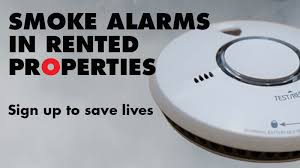
October 2019
Smoke Alarm and Carbon Monoxide Alarm legislation
As a recent question arose on the regulations for smoke alarms and carbon monoxide alarms, we thought it worth clarifying the current legislation.
The Government introduced the Smoke and Carbon Monoxide Alarm Regulations (2015) to make landlords in the private rented sector in England responsible for ensuring that smoke and carbon monoxide detectors are appropriately installed and are in proper working order at the start of a new tenancy.
The law applies to landlords renting residential accommodation to one or more tenants occupying all or part the property as their only or main place to live.
As from 1 October 2015 landlords have to ensure that a smoke alarm is fitted on every floor of their property where there is a room used wholly or partly as living accommodation. They will also have to put a carbon monoxide alarm in any room where a solid fuel is burnt, such as wood, coal or biomass and includes open fires. It does not include gas, oil or LPG.
Landlords or agents will then have to ensure that the alarms work at the start of each new tenancy. For example, by pressing the test button until the alarm sounds. The start of each new tenancy is the first day of the tenancy and the first day of the tenancy is the date stipulated in the tenancy agreement (even if the tenant decides to actually move into the property on a later date).
Landlords are also required to demonstrate that the alarms were working at the start of the tenancy, so it is advisable to get the tenant to sign a receipt confirming the smoke and carbon monoxide alarms are working or ensure it’s in the inventory at check-in which is signed by the tenant.
During the tenancy it is a tenant’s responsibility to ensure the alarms work and it is their responsibility to change the batteries during the tenancy. However, should the alarms become faulty during the tenancy landlords are responsible for replacing them.
Under the proposals, a bathroom or lavatory is classed as a room used for living accommodation and a room covers halls or landings. Stairways are also included in the regulations. For instance, for maisonettes or flats above shops where the flat is on the first floor but you enter via stairs on the ground floor a smoke alarm will be required in the stairwell.
In addition, landlords do not need to check the alarms when a tenancy is renewed under the same conditions i.e. for the same premises by the same landlord to the same tenant.
An explanatory booklet to help landlords further understand and comply with the Smoke and Carbon Monoxide Alarm (England) Regulations 2015 has been issued by The Department for Communities and Local Government (DCLG) available through the link below: